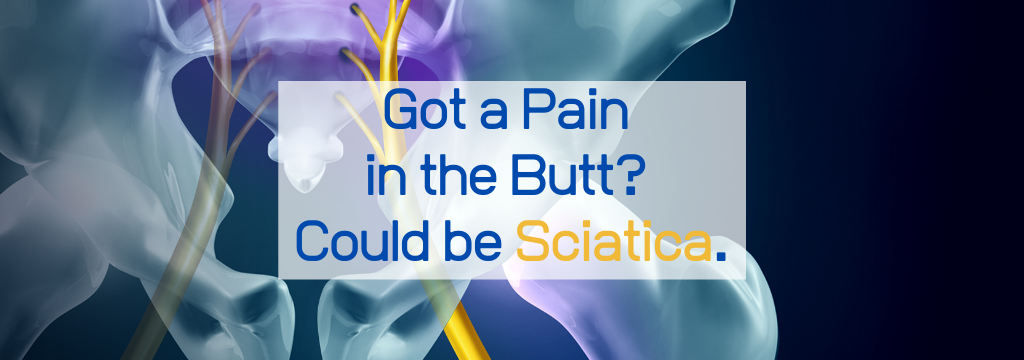Got a Pain in the Butt? Could be Sciatica.

It’s true – you’d be surprised at the number of Rolfing clients who walk in and point to their butt, complaining of sciatica. My first step is to determine through diagnostics which nerves are causing problems, like if the visceral system is even involved.
Here’s what happens with sciatica. The sciatic nerve (root of sciatica) begins in L4 – S3 (L meaning Lumbar vertebra and S meaning Sacral segments) and goes down the back of your leg, continuing into your feet. If that nerve is “pinched” anywhere along the line, you’ll feel pain. It can cause issues walking, standing, lying down – in fact, sciatic nerve inflammation can be a pretty miserable situation.
Nerves can be tricky. They talk a lot amongst themselves, sharing irritation. They’re reliable in that you know when something hurts. Yet getting specifics on where the hurt begins isn’t always as obvious. One compressed nerve tells all the connected nerves, then the brain, that things aren’t right. Well, then the brain gets involved and suddenly you feel like lots of areas are inflamed. Say, for instance, your toe hurts. That doesn’t necessarily mean your toe is injured, just that the nerves in your toe feel pain. The origination point could be somewhere way up the line.
I’m 2/3 the way through the series with Mr. Horan and it’s been incredible to see my posture improve and my long-time sciatica go away completely. – M. Fish, Horan Rolfing Client
What happens when you tell me, “I think I have sciatica.”
I’m going to look at the potential sciatic nerve compression points – spinal, muscular and organ. This is why the ability to discover the start of  your discomfort is so important to resolving it. Every potential cause needs assessment. If you have damage to an intervertebral disc in the spine, protrusion into the nerve area can irritate the sciatic nerve. Or say the nerve is perfectly fine in the spine, but then the rectum or the sigmoid colon (both organs that sit right in front of it) compress the nerve causing pain. Then there’s the deeply seated piriformis muscle, a common source of sciatic nerve pain, tingling, or even numbness that runs down the leg or into the foot, as in piriformis syndrome.
your discomfort is so important to resolving it. Every potential cause needs assessment. If you have damage to an intervertebral disc in the spine, protrusion into the nerve area can irritate the sciatic nerve. Or say the nerve is perfectly fine in the spine, but then the rectum or the sigmoid colon (both organs that sit right in front of it) compress the nerve causing pain. Then there’s the deeply seated piriformis muscle, a common source of sciatic nerve pain, tingling, or even numbness that runs down the leg or into the foot, as in piriformis syndrome.
As a Certified Rolfer, my aim is to 1) diagnose the actual pain source, and 2) free up the affected structures. Here’s also where balance is so important to the surrounding areas. It may call for evaluation of your movement patterns. It’s common for habits in gait, stance, or sitting to affect our bodies. Exercise routines could be exacerbating an issue. We’ll look at how retraining those habits or adjusting routines could help.
Christopher Horan’s Rolfing therapies help alleviate issues from sciatica. His mission is to help restore freedom of movement without pain. You can schedule a Rolfing appointment with him in Horan Rolfing’s Tacoma or Bellevue office. Sciatic nerve pain relief is only a call away!